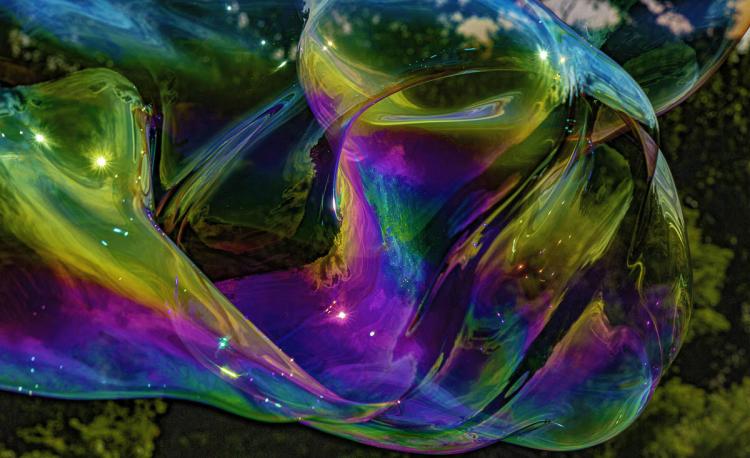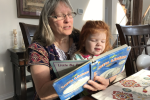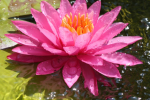In my soul, there is a temple,
a shrine, a mosque, a church
where I kneel.
—Rabia
I had been in international settings many times in my life before this one. But until now, it had always been simply a collection of multiple peoples from multiple countries and multiple religions all coming together under the banner of common concerns. The Beijing Conference on Women, for instance, brought women from all over the world to consider the role of women in the world.
In the Soviet Union it was a gathering of American and Soviet peoples of all stripes and ethnic backgrounds who were trying to make peace in a nuclearized world before our governments made that impossible to accomplish.
This time was very different. This time we were all there - Christians, Jews, Muslims, Buddhists, Hindus, and every variety of each - to join together as women, as professional religious figures to bring women into the peacemaking arenas of the world in order to demonstrate the peace we sought in the religions we followed.
Clearly, then, the Global Peace Initiative of Women confronted us all with the challenge to make religion real. After all, we each and all—every single one of our traditions--preached peace. The question was what were we really doing to bring it about?
No doubt about it: this issue, this interfaith conference, had global dimensions. Most of all, it was a kind of universal examination of conscience. Religion, we all had to admit, had done as much to breed wars as it ever had to bring the peace we said we were about. And where it wasn’t the cause of the war, it did a lot to maintain it—as in Northern Ireland or Iraq or Israel or India. And multiple other places around the world.
But what would we do differently that could possibly not only break down the barriers between us but even create some real spiritual bonds? We were only women. Not politicians. Not preachers. Not negotiators. Not armed. We had not so much as a slingshot among us from which to disarm ourselves.
But then something happened that changed the entire conference, gave it truth, made it real.
The schedule called for a “Day of Prayer.” Yawn. Who hasn’t been to one of those. Nice but hardly earthshaking. Except that this one was different. In this day of prayer, every denomination, every major religious leader there, got up and led the conference in a prayer for peace from her own tradition.
At first, it seemed like it was going to be a long day of foreign recitations. Dull. But then, little by little, women began to join in. The singing got stronger; the chanting got fuller; the room got quieter, deeper, calmer. We weren’t strangers anymore. We had honored a common God. We had honored one another’s honoring. We had listened to another way of bringing peace, heard the message of it in another voice, lived in the same cosmic rhythm together and found it to be One.
God had taken all of us beyond our one tongue to the God of many tongues.
Our God had become bigger—and we, as well.
The one God had brought us all into Oneness.
I understood something that day in a way I never had before: Beware the religion that turns you against another one. It’s unlikely that it’s really religion at all.
“I didn’t really want to come to the meeting,” a woman wrote afterwards, “but the Day of Prayer completely changed my mind—about a lot of things.”
Tuesday, February 1: God is too great to be fully captured by any of us. But we all do see some of the aspects of God—community, peace, justice, endlessness, presence, incarnation, transcendence—more clearly than we see others. And that is the light that shines from each of us to the other.
Wednesday, February 2: When our own faith leads us to see the face of God in all the others, too, then we have surely reached the acme of our own.
Thursday, February 3: God speaks in many tongues, glows in many colors, calls to us in many voices, is beyond any puny little parochial image we make of God. It is this great cosmic God we seek.
Friday, February 4: Never doubt that another person’s path to God is as good as your own. “There are many good moccasin tracks along the trail of a straight arrow,” the Sioux say. It’s the straightness of the arrow that takes us to God that matters in the end.
Saturday, February 5: To allow religion to divide us is to know little about religion at all. “We are all one child spinning through Mother Sky,” the Shawnee taught. Western Culture calls it “the human family” but the meaning is the same
Sunday, February 6: Remember: No one fights about God. We only fight about what is the best way–the only way, the “true” way, the “right” way—to get to God. Which makes the project more personal than divine.
Monday, February 7: If we really believe in God, how can we possibly believe that we also really know what God is like, let alone who God loves most? “Faith,” John Ralston Saul wrote, “is the opposite of dogmatism.”
Tuesday, February 8: When we do not understand the religious images or language of the other, we call them “pagan.” And yet they seek what we seek, they want what we want, they teach what we teach about the nature of God and creation. They simply teach it differently. So, if God is as small as we seem to think, then who of us is really pagan? “Forgive him,” George Bernard Shaw wrote, “for he believes that the customs of his tribe are the laws of nature!”
Wednesday, February 9: God calls to every heart individually and personally. How we choose to answer is the choice we each must make. But that takes depth and discernment, sincerity and grace. We are not born spiritual people. We can only become that by making God the center of our lives. “Faith is not making religious-sounding noises in the daytime,” Mary Jean Irion wrote. “It is asking your inmost self questions at night....”
Thursday, February 10: Dogmas are signposts along the road of the soul on the way to God. They are meant to open our minds to mystery. They are not meant to keep us from learning about God in other places and ways.
Friday, February 11: When we reduce religion, faith, spirituality to dogmas, we run the risk of using them to protect us from going deeper into God. “They were so strong in their beliefs,” Louise Erdrich wrote, “that there came a time when it hardly mattered what exactly those beliefs were; they all fused into a single stubbornness.”
Saturday, February 12: When we stop separating things into them and us, into true and false, into sacred and mundane, into religious and irreligious, we run the risk of seeing God everywhere. “Everything above and below,” the Baal Shem Tov taught, “is one unity.” Now does that sound like heresy to you?
Sunday, February 13: To have “faith” does not mean that we go to one church and respect no other. It means that we believe that the God who speaks to all people somehow is speaking to us in this particular way. “Dogma,” Flannery O’Connor wrote, “can in no way limit a limitless God.”
Monday, February 14: We say we have faith when what we really mean is that we have absolute certainty about things that are absolutely uncertain. “Faith,” Mary Jean Irion wrote, “is crumpling and throwing away everything, proposition by proposition, until nothing is left, and then writing a new proposition, your very own, to throw in the teeth of despair.”
Tuesday, February 15: “What is the deepest meaning of Buddhism, Master?” the disciple asked. And in answer, the Zen masters tell us, the teacher only bowed. It is in being able to find the sacred in everything that a person finally discovers God.
Wednesday, February 16: Religious differences are not there to be fought over. They are there to give us new insights. “If you disagree with me,” Dom Helder Camara taught, “you have something to give me. If you are sincere and seek the truth as best you may, honestly, with modest care, your thought is growth to mine … you deepen my vision.”
Thursday, February 17: The Chuang Tzu taught: “When the shoe fits, the foot is forgotten. When the belt fits, the belly is forgotten. When the heart is right, ‘for’ and ‘against’ are forgotten.” Which makes you wonder whatever happened to the “religious” hearts we so proudly parade—even in our political arenas.
Friday, February 18: It is not “understanding better” that saves us; it is “understanding with” that makes our ideals real. Or as the Buddha taught: “In separateness lies the world’s great misery; in compassion lies the world’s true strength.”
Saturday, February 19: So if God is One and calls us all into Oneness, what stops it from happening? A Chinese proverb gives us a clue. “There are three truths,” the proverb tells us: “My truth, your truth and the truth.” Make it the Eleventh Commandment.
Sunday, February 20: We all sit around waiting for someone else to change the world, to change our attitudes, to change our politics, to change the way the world thinks. But the fact is that the way we go the world goes. The great spiritual exercise is to determine what it is in ourselves that makes peace impossible somewhere—in the family, in the church, in the world.
Monday, February 21: If we really understood God, if mystery were simply not part and parcel of religion, what kind of a god would that be? “A religion that is small enough for our understanding,” Arthur James Balfour wrote, “would not be large enough for our needs.”
Tuesday, February 22: Some people want inerrancy, accuracy, and perfect certainty more than they want either the spiritual life or faith. These people pride themselves on their orthodoxy, their religious correctness, their theological truths. But be cautious about it all. “Orthodoxy, my Lord,” said Bishop Warburton, in a whisper, “orthodoxy is my doxy; heterodoxy is another man’s doxy.”
Wednesday, February 23: When we really begin to understand that God is everywhere, in everyone, alive in the world always, then life becomes a joy, not a burden, and other people a sign of possibility, not danger. Then we learn to laugh again.
Thursday, February 24: To recognize God in others is to extend the boundaries of the self. Then God and we are not a world to ourselves. We are simply a missing piece in the glories of the universe.
Friday, February 25: A life filled with the awareness of God, a sense of the security of God, an appreciation of the creativity of God is a life full of the laughter that comes from knowing that everything is holy and, eventually, everything will also come out right.
Saturday, February 26: How do I know if I’m finally becoming closer to God? Easy. It’s when I see God in everyone I meet and touch God in everything that is.
Sunday, February 27: How do we know if the religion we say we hold so dear and believe so deeply and practice so well is as developed in us as we think it is? Nick Annis wrote, “Here’s a tip: If you’re killing someone in the name of God—you’re missing the message.”
Monday, February 28: I had a friend who told me to watch what I prayed for because I would surely get it. Then, I figured it out: If you pray for hope, you will surely suffer despair; if you pray for love, you will surely feel the power of hate; and if you pray for faith, you will certainly know doubt. And when you put it all down and believe that God is in it all, God will be there.
Let’s Share Our Thoughts
The following discussion questions, Scripture echoes, Journal prompts, and prayer are meant to help you reflect more deeply on The Monastic Way. Choose at least two suggestions and respond to them. You may do it as a personal practice or gather a group interested in sharing the spiritual journey. Once a month The Monastic Way staff will convene a Zoom conference where you can share your insights. Three times a year Sister Joan Chittister will join that Zoom conference to give more input and respond to your questions and ideas regarding one issue of The Monastic Way.
Discussion questions:
1. How would you answer the question, Who is God? How would you have answered the question as a child? As a young adult? Has your idea or definition of God changed through the years? Explain.
2. Which daily quote in The Monastic Way is most meaningful to you? Why? Do you agree with it? Disagree? Did it inspire you? Challenge you? Raise questions for you?
3. After reading The Monastic Way, write one question that you would like to ask the author about this month’s topic.
4. Joan Chittister uses other literature to reinforce and expand her writing. Find another quote, poem, story, song, art piece, novel that echoes the theme of this month’s Monastic Way.
5. Sister Joan asks, “How do I know if I’m finally becoming closer to God?” And she answers: “Easy. It’s when I see God in everyone I meet and touch God in everything that is.” Do you agree with her or would you give a different answer?
Scripture Echo
“Does not Wisdom call out?
Does not understanding raise her voice?
On the heights along the way,
where the paths meet, she takes her stand…”
—Proverbs 8:1-2
What does this passage on Wisdom say to you about the importance of interreligious dialogue, about reverencing another person’s path to God?
Journal Prompts
Prompt 1: Here are a few statements from this month’s Monastic Way. Choose one that is most helpful to you and journal with it:
•God is too great to be fully captured by any of us.
•To allow religion to divide us is to know little about religion at all.
•God speaks in many tongues, glows in many colors, calls to us in many voices.
Prompt 2: Spend a few minutes with this photograph and journal about its relationship to this month’s Monastic Way. You can do that with prose or a poem or a song or….
Prayer
I bow to the one who signs the cross.
I bow to the one who sits with the Buddha.
I bow to the one who wails at the wall.
I bow to the one who faces Mecca,
whose forehead touches holy ground.
I bow to dervishes whirling in mystical wind.
I bow to the north,
to the south,
to the east,
to the west.
I bow to the God within each heart.
I bow to epiphany, to God’s face revealed.
I bow, I bow, I bow.
—Mary Lou Kownacki
JOAN CHITTISTER is an internationally known author and lecturer and a clear visionary voice across all religions. She has written more than 60 books and received numerous awards for her writings and work on behalf of peace and women in the church and in society.
KAREN BUKOWSKI, an Erie native, is a nature photographer and former LPGA and PGA Golf Professional who holds a master’s degree in public administration. Visit karenbukowskiphotography.com to find many nature and landscape photographs.

 Artwork: by Karen Bukowski
Artwork: by Karen Bukowski




